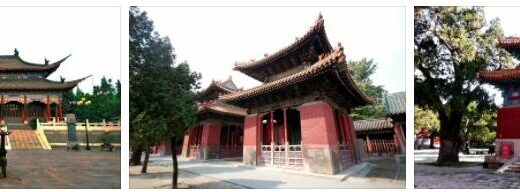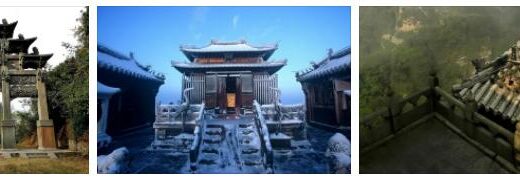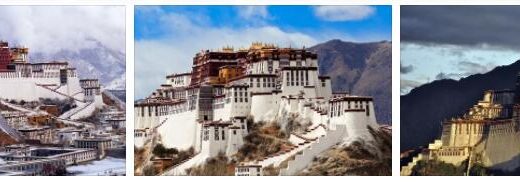Jiuzhaigou Valley Landscape Park (World Heritage)
The Jiuzhaigou Valley in Sichuan Province extends over an area of 720 km² between 2140 and 4558 m altitude. The numerous rivers are lined with dense mountain forests, steppes, mountain meadows, bamboo forests or reed meadows. The scenic highlights include several spectacular waterfalls and colorful shimmering lakes. Jiuzhaigou is also home to the giant panda, whose population is endangered.
Jiuzhaigou Valley Landscape Park: Facts
| Official title: | Jiuzhaigou Valley Landscape Park |
| Natural monument: | over an area of 720 km² the Jiuzhaigou valley with heights of 2140 m (Luveihai) to 4558 m (Ganzigonggai); almost untouched until a few decades ago due to the difficult accessibility; The “lake terraces” with lakes such as Shuzheng and Nuorilang and spectacular waterfalls such as Xionguashai with 78 m in three steps and Zhengzhutan with a “water curtain” 310 m wide are of particular scenic beauty; 1972 and 1979 intensive logging, 1982 set up as a nature and landscape park, 1997 designation as a world biosphere reserve, 2004 award as “National Geographic Garden” |
| Continent: | Asia |
| Country: | China, Sichuan |
| Location: | north of Huanglong History and Landscape Park, north-northwest of Chengdu |
| Appointment: | 1992 |
| Meaning: | impressive karst landscape and home to the endangered panda bears and the scechuan takin |
| Flora and fauna: | 300 km² of primary forest with 92 plant species, which are of particular importance in traditional medicine because of their rarity, endemism or their use; 15 rhododendron species at 2000-4000 m and bamboo species such as Fargesia denudata and F. chinensis as important food for the panda bear; Mammals such as golden snub nose, goral, serau and white-lipped deer; 141 bird species such as the glossy green-tailed pheasant, the jayfish species Garrulax sukachevi and a subspecies of the rough-footed owl |
Where the goddess broke her mirror
Li Bai, probably the most famous poet of the Tang dynasty, noted in the 9th century: “It is probably easier to get to heaven than to Sichuan.” To achieve river crossings. For a friend who had been exiled to Sichuan – at that time the Shu Kingdom – Li Bai wrote a warning in verse: “The road to Shu – it should be a rocky path. Not easy to walk, as people tell you… «Today, Sichuan is no longer the remote area it once was, those responsible in Beijing have long been aware of the treasure they manage here: the most beautiful nature reserve in the People’s Republic of China, Jiuzhaigou – in English: nine-village valley.
Enchanting, magical, incomparable – descriptions rave about in the highest tones. From Sichuan’s capital Chengdu, it’s almost 300 kilometers to Jiuzhaigou, but the streets in the cities along the way are chronically congested. However, this does not deter the visitor from the enchanting natural spectacle. While in 1984 around 5,000 visitors a year came, almost 20 years later the figure was already 7,000 a day, and the trend is rising.
For much of the way, the road meanders along the banks of a river on which hundreds of tree trunks drift down into the valley. This type of transportation is a game of chance with nature: a considerable amount of the precious wood gets stuck on river banks or becomes entangled in bends and rots there. Such depletion of resources and a landscape that is marked by the cancerous growth of erosion make all the more receptive to the beauty of nature, as it ultimately extends over 700 square kilometers in the landscape park.
Steep slopes, deep valleys and lush forests are only the backdrop for the real attraction of the landscape park: 108 crystal-clear lakes that run through the mountains like a string of pearls. The largest of these water points is the so-called “Long Lake” at seven kilometers, which is already 3100 meters above sea level. Others are more like ponds, but their play of colors is no less brilliant than the larger ones. In the sunlight, some of them shine in a green-blue that seems almost artificial in its intensity. And in late autumn, when the forests ignite in red and gold, the kaleidoscope of colors is reflected in such a picturesque way, especially in the smaller lakes, that they have been christened »rainbow ponds«.
Scientists argue about how nature shaped this arrangement. Some believe that fallen tree trunks that have been enlarged to form dams by limestone deposits have dammed the mountain rivers into lakes over time. Another theory is that the Jiuzhaigou chain of lakes was formed by glaciers. Be that as it may, the most beautiful genesis is the one that comes from the world of legends. It is said that a beautiful goddess dropped her mirror on the ground and it broke into 108 pieces. Every shard a lake – that is the stuff that fairy tales are made of in China according to physicscat.
Only with the term magic or fairy tale world does justice to the scenery that presents itself in the middle of the valley as a deafening spectacle. It hisses, it sprays, it glitters, shines and glows. Over a length of 140 meters, the Nuorilang waterfalls plunge into the depths, in ever new colors and formations – silvery, white, rosé – sometimes as a delicate web, sometimes in foaming force. Symbol of constancy in the restless play of water: the silhouettes of gnarled trees that, obviously firmly rooted, defy the steady flow.



